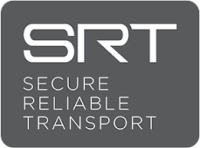Table of Contents
SRT Basics
SRT (Secure Reliable Transport) is an open-source video transport protocol. It optimizes streaming performance over unpredictable networks such as the Internet by dynamically adapting to real-time network conditions. It is best suited to transmit video and/or audio over the public Internet. SRT also copes well with highly fluctuating bandwidths. The quality of the transmission improves with an increase in latency. Multiple SRT streams from the same remote site arrive at the receiver simultaneously if all streaming parameters are set the same.
SRT is based on the UDP protocol. UDP is a so-called connectionless protocol. The previously known TCP had too many disadvantages regarding speed. TCP is intended for applications, which depend on a complete and secured transmission. UDP, however, does not depend on an existing connection but simply sends its data to a known address on a known port. But this also means that the sender does not know whether his sent data packets have arrived. While TCP sends acknowledgements when receiving data, UDP does without. This has the advantage that the packet header is much smaller and the transmission path does not have to transmit acknowledgements. UDP was constantly further developed to RTP and finally to SRT. The further developed protocols can request lost packets again within a certain range and also in terms of security SRT was satisfied with a maximum AES265 encryption. The disadvantage of SRT regarding port forwarding will be eliminated with the future RIST protocol. As with SRT, RIST will also take some time until market-ready solutions are available. With SRT, introduced in 2017 by Haivision with reference applications as OpenSource, it also took a while until it landed here;-)
Features
- Input and output (send and receive) support for Caller, Listener and Rendezvous connection methods.
- Optional 128, 192 or 256 bit encryption
- Hardware (GPU) accelerated encoding and decoding of HEVC or H264 video in up to 4K (if supported by existing hardware and operating system).
- Up to 8 channels of AAC audio.
SRT knows 3 different connection types
- Caller The caller side is the side from which you do NOT know or cannot use the public IP address. (e.g. a mobile phone or a GSM modem)
- Listener the Listener side is the one from which you know the public IP address.
- Rendezvous in rendezvous mode both nodes initiate communication. Rendezvous mode is used when both nodes are behind firewalls and should allow communication without configuring the firewall. Most of the time (in 99% of all cases) Rendezvous only works behind a router, because of PAT (Port Address Translation) the ports can not be forwarded correctly.
Why Rendezvous Mode is actually not used, you can read here.Why Aren't People Using SRT's Rendezvous Mode?
It is important to understand that the three types of connections have NOTHING to do with the direction of transmission.
RULE: the remote location is always the caller, the studio is always the listener, regardless of whether the outstation is receiving or transmitting a signal.
Internet line requirements (up or down)
SRT streams are always progressive.
- for a SD stream approx. 2Mbit/s
- for a HD 720 stream minimum 2Mbit/s, recommendation 2 - 3.5Mbit/s, optimal 4 Mbit/s
- for a HD 1080 stream minimum 3Mbit/s, we recommend 4 - 6Mbit/s, optimal 10 Mbit/s\
- for a UHD stream minimum 25Mbit/s, we recommend 50Mbit/s, optimal 100Mbit/s
Hardware and Software for SRT
the following lists are not complete…
Hardware-Encoder and-Decoder
Kiloview
Haivision the inventors
Teradek 600 oder 700 Serie
Matrox®
Monarch™ EDGE, 4K/Multi-HD Remote Production Encoder and Decoder (withTally and TB)
OnPremise SRT rpiPlayer SRT Decoder (onlyH264) with a Rasperry RPi2, RPi3 oder RPi4 (freeware)
